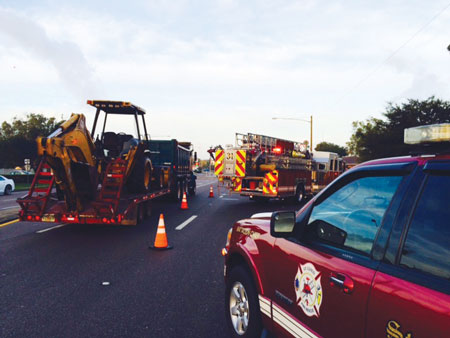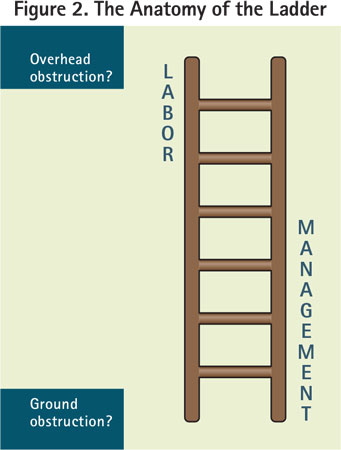
By Ryan Gallik
Asking yourself “How effective is my safety committee” certainly doesn’t get your adrenaline rushing, and it definitely isn’t the most popular topic in the fire service. However, it’s a topic that must take priority to ensure that an organization is identifying, evaluating, prioritizing, and controlling risks that can potentially lead to bad outcomes. Most importantly, the employer and the members of the fire department should ensure that they are doing everything possible to see that everyone goes home at the end of their shift. While you read this article, expand your vision and see if your organization has issues lying in wait. Perhaps you can take it a step further and perform a risk assessment of your organization and then determine a strategic plan to mitigate those issues that could lead to an occupational injury, an illness, a disease, or even death.
 |
| (1) St. Cloud (FL) Fire Rescue implemented the Traffic Incident Management Program, which is now part of the National Unified Goals. (Photos by author.) |
Let’s be realistic. We’re in an inherently dangerous profession, but that doesn’t allow us to perform unsafe acts and not make safety a priority. It’s an honor to serve our communities and to ensure that those who reside and visit have a safe community through public education and fire prevention and the services we provide. It’s time for all fire service members to bring that same level of passion to making safety a priority for themselves and their fellow firefighters. How can we accomplish this? It’s about having an effective safety committee.
The Safety Committee
The safety committee can be that change your organization needs. Having an effective safety committee could change the culture of new and seasoned firefighters. Our fire department is more than 100 years old and has a rich tradition and history. The fact that no one was killed or significantly injured here is nothing shy of a miracle. In 2012, we made the change that was needed to make us a premier department that leads by example, has servant leadership, and exemplifies true brotherhood and sisterhood.
 |
| Our committee conducts an annual evaluation survey online among department members to obtain their input. We want them to know that we care about what they think. |
An assistant chief came onboard and guided us to a safer place. He soon started building trust among the members, as a true leader would do, and achieved full followership. He performed a SWOT (Strengths, Weaknesses, Opportunity, and Threats) analysis and implemented a strategic plan that encouraged involvement by the entire organization. During this time, he noticed that we didn’t have a safety committee, which is a violation of Florida administrative codes, and the Bureau of Fire Standards and Training also learned that we weren’t supporting all of Florida Administrative Code 69A-62.
A safety committee was established. I indicated my interest in serving on the committee; my peers selected me as its chair, which led to the chief’s designating me as the chair. I researched extensively for information that would help me to ensure that the safety committee and I were actively moving toward decreasing injury, illness, and occupational disease-and prevent a line-of-duty death.
Coming Full Circle and Seeing Positive Results
After several years, our safety committee had reduced our workers’ compensation claims significantly-from $664,667.46 in 2012, to $164,671.20 in 2013, and to $8,791.48 in 2014. Today, we have National Fire Protection Association (NFPA) 15821-compliant firefighter physicals and new self-contained breathing apparatus; we removed the ice machines from the apparatus bay2 and support flow path management and the International Safety and Health Fire/EMS Safety week. We train on critical tasks that affect life safety such as crew resource management, accountability, Mayday drills, and rapid intervention. We evaluate our effectiveness by inviting each member to participate in an annual survey on safety issues (Figure 1).
 |
| Note how the beams (named Labor and Management) support the rungs. Without the supporting beams, you wouldn’t be able to climb the rungs to success in reporting safety concerns. If the danger is immediate, members shall notify the health safety officer or a member of the Safety and Health Committee immediately. |
A safety program is effective only when there is buy-in from the entire department and each member participates in reducing risks and supporting best practices.
How effective is your safety committee? Do you have a safety committee? If you have a safety committee or a safety coordinator, do you have data that support that the safety program is effective? Have your workers’ compensation claims decreased, and have the number of firefighter injuries and illnesses been lowered? If you’re questioning the success of your committee or if you don’t have one, get ready, we’re going to climb a ladder to success.
Climbing the Ladder to Success
Safety first! Check for ground obstructions (pick your feet up and get moving), and check for overhead obstructions (management, budget restraints, for example). Now that we have completed the safety check, let’s start the climb (Figure 2).
- Rung number 1. Build a safety committee with members who are passionate and eager to make positive changes in the organization. Have your committee be less management driven, and allow those boots-on-the-ground personnel to lead the committee with the guidance of management/administration. Select members from your department. It’s best if volunteers fill the positions instead of members who have had the safety roles forced on them. Although safety is everyone’s responsibility, having a committed and progressive safety committee can bring much success.
- Rung number 2. Perform a risk assessment or a SWOT analysis of your organization. If you’ve taken any type of risk management class, you understand that identifying risks is the first step in risk management. The National Fallen Firefighters Foundation has a great Vulnerability Assessment Program that’s worth checking out (www.firevap.org).
- Rung number 3. Be prepared to have a leg lock, as this can take some time. After reviewing the risk assessment and the SWOT analysis, support your strengths, mitigate your weaknesses, embrace and take advantage of your opportunities, and manage your threats appropriately. Once you have the information, develop a strategic plan for controlling the threats and determining what you need to begin your climb for continued success. The strategic plan can be short term and/or long term. Ensure that you’re always getting closer to the goals (Figure 2). If your organization begins the climb and takes it rung by rung, you’ll have a systematic, realistic, and obtainable system to follow.
- Rung number 4. Begin reviewing or updating your policies and procedures and ensuring that they’re up to standard, especially the respiratory protection plan. Does your policy state that you have, at minimum, a medical evaluation, which is compliant with Occupational Safety and Health Administration CFR 1910.134? Are members fit tested if there’s a weight gain or a loss of 10-15 pounds or a change in medical history? How about the Mayday policy? Do you have a risk management plan integrated with incident management? Is there an incident/accident investigation policy you can use to identify root causes to prevent further occurrences?
- Rung number 5. Begin to train on those policies and procedures to make sure you have a solid foundation in understanding what’s been updated/changed. It’s extremely important to have consistency within the organization. Also seek opportunities to train on how to conduct effective safety committee meetings, record minutes, and keep the members up to date. This is also a good time to review potential state statutes that may have firefighter safety and health mandates that should be followed. The Florida State Statute covers The Firefighter Safety and Health Act.
- Rung number 6. Ensure you’re continuously growing, adapting, and sharing information and that you initiate an evaluation process for your safety committee. You might institute a safety suggestion box where members can submit their ideas to the committee (Figure 2). Safety and health issues needing immediate attention should be directed to the health safety officer or a member of the safety and health committee as soon as possible.
If you follow some of these recommendations and put common sense into common practice, you will soon see that your organization is well on its way to reducing risk and supporting best practices that will reduce injuries and illness and the potential for line-of-duty deaths.
Endnotes
1. National Fire Protection Association 1582, Standard on Comprehensive Occupational Medical Program for Fire Departments, 2013 edition.
2. Our committee supports the Firefighter Cancer Support network; thus, we have moved our ice machines and all of our bunker gear away from the apparatus bays.
RYAN GALLIK, who is a 13-plus-year veteran of the fire service, is a firefighter/paramedic with the St. Cloud (FL) Fire Rescue Department. He is the chair of the department’s safety committee and the chair and co-founder of the Regional Safety Collaborative of Central Florida. He teaches minimum standards at Valencia College and assists other departments in developing effective safety committees. He is trained to the technician level in hazmat, rope rescue, and confined space and is an EVOC instructor, fire service instructor I, and fire officer I. Gallik attended the Safety Program Operations course at the National Fire Academy and has been a guest speaker at the Florida Fire Chiefs Association Safety and Health Conference and for Preferred Governmental Insurance Trust.
Fire Engineering Archives

